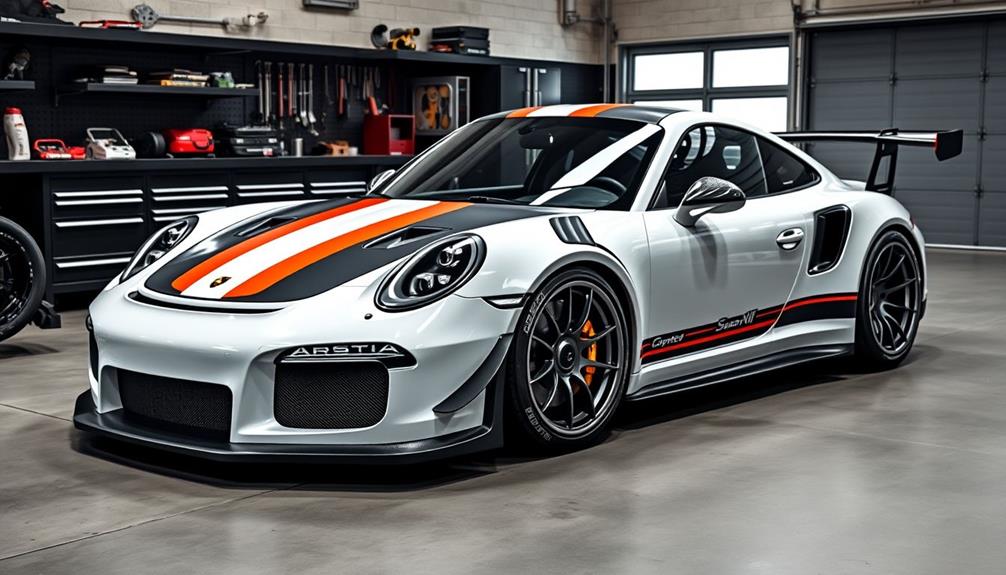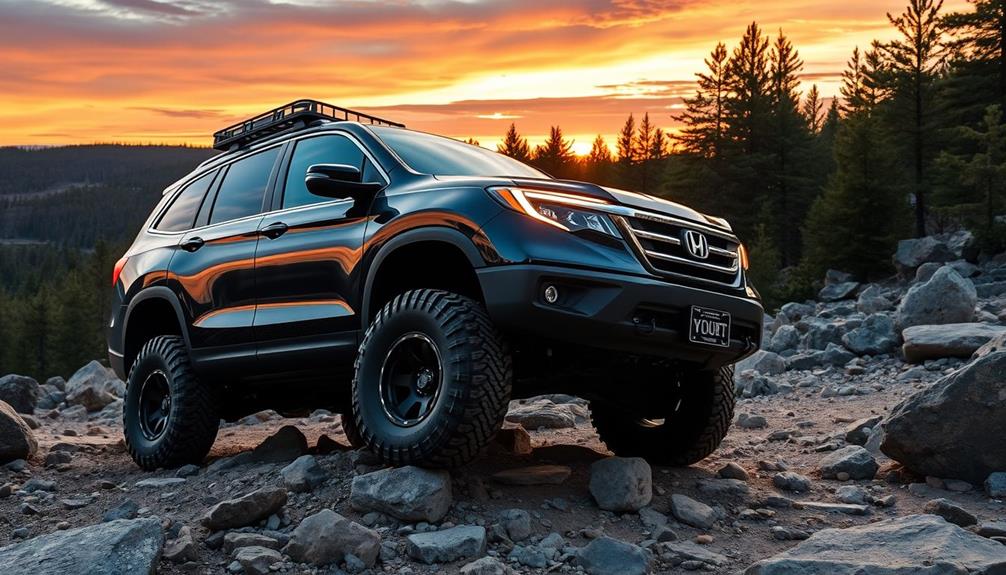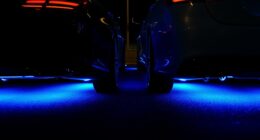Tuning your 2003 Honda CR-V can greatly boost its performance and driving experience. Start with engine upgrades like a K&N air filter or a Fujita short ram intake to enhance airflow. Consider a supercharger for major power gains and use ECU tuning to optimize engine efficiency. Don't overlook suspension improvements; installing performance shocks and sway bars will enhance handling. Upgrading your brake system with better pads and rotors can improve stopping power. Finally, keep up with maintenance to protect your upgrades. With these modifications, you're on track to transform your SUV into a more responsive ride. There's plenty more to explore.
Key Takeaways
- Upgrade the air intake system with a cold air intake and performance filter to enhance airflow and increase horsepower by 5-10 hp.
- Install performance shocks and sway bars to improve handling, reduce body roll, and enhance cornering stability for a sportier driving experience.
- Consider a supercharger kit for significant power gains of 30-100 hp, but ensure compatibility with upgraded fuel injectors and ECU tuning.
- Enhance braking performance with high-performance pads and slotted rotors to improve stopping power and prevent brake fade during spirited driving.
- Regular maintenance practices, including oil changes and fluid replacements, are essential to ensure reliability and performance longevity after tuning modifications.
Performance Modifications Overview
When it comes to tuning your 2003 Honda CR-V, performance modifications can make a noticeable difference in both power and handling. To kick things off, consider upgrading your engine with performance parts like a K&N drop-in air filter or a Fujita short ram intake. These enhancements improve airflow, giving you a slight horsepower boost of 2-3 hp.
Additionally, enhancing your vehicle's aesthetics can contribute to a feeling of confidence while driving, similar to how astrology influences self-image in personal interactions.
Next, upgrading your exhaust system with components like the OBX catback exhaust and header can greatly enhance exhaust flow and sound, although be prepared for a bit of a challenge during installation.
For better handling, think about installing Bilstein Heavy Duty shocks or Koni Sport Yellow shocks, which can improve ride quality and responsiveness.
Don't overlook your braking system, either. Performance brake upgrades like Hawk HPS brake pads and Power Slot slotted rotors can provide enhanced stopping power, essential for safety during aggressive driving.
Finally, utilizing Hondata tuning can result in performance gains of around 30 hp/tq, optimizing your engine performance for a more efficient and responsive driving experience.
With these modifications, you'll transform your CR-V into a more dynamic vehicle.
Engine Performance Enhancements

If you're looking to boost your 2003 Honda CR-V's engine performance, starting with a cold air intake can help improve airflow and efficiency.
This is similar to how diversifying your investments can enhance financial stability through diversification strategy.
For a more significant upgrade, consider installing a supercharger kit, which dramatically enhances horsepower and torque.
These modifications not only elevate your driving experience but also keep your engine running at its best.
Cold Air Intake Benefits
Upgrading to a cold air intake system can greatly boost your 2003 Honda CR-V's engine performance. By enhancing airflow to the engine, a cold air intake improves combustion efficiency, resulting in an estimated increase of 5-10 horsepower for your K24A1 engine. You'll also notice improved throttle response, allowing for quicker acceleration when you need that extra power.
One of the key benefits is the ability to lower intake air temperature. Cooler air means more oxygen for combustion, which is particularly beneficial during high RPMs. Plus, many aftermarket cold air intakes feature washable and reusable filters, cutting down on long-term maintenance costs.
Installing a cold air intake is straightforward and often requires minimal tools, making it an accessible upgrade for CR-V enthusiasts. Here's a quick overview of the benefits:
| Benefit | Description |
|---|---|
| Increased Horsepower | Gain 5-10 extra horsepower |
| Improved Throttle Response | Quicker acceleration |
| Lower Intake Temperature | Enhances power output at high RPMs |
| Cost-Effective Maintenance | Washable filters reduce long-term costs |
| Easy Installation | Minimal tools and expertise needed |
Make the upgrade and enjoy the difference!
Supercharger Installation Options
Boost your 2003 Honda CR-V's performance with a supercharger installation, a powerful upgrade that can greatly enhance horsepower and torque. Options like the Comptech and Jackson Racing superchargers are excellent choices, offering impressive power gains ranging from 30 to 100 horsepower depending on the specific kit and supporting modifications.
Additionally, understanding the common reasons for heat pump failure can help you maintain your vehicle's performance in varying weather conditions.
To guarantee your engine runs at its best with the added boost, you'll need to make some additional modifications. Upgrading your fuel injectors and installing a performance chip for ECU tuning are essential steps. These changes accommodate the increased air intake, ensuring your engine performs at its peak.
One of the biggest advantages of a supercharger over turbochargers is the instant power delivery. If you're looking for immediate throttle response, a supercharger is the way to go.
However, regular maintenance post-installation is vital. Keep an eye on your oil changes and monitor boost levels to prevent engine strain and assure long-term reliability.
With a well-installed supercharger, you'll transform your CR-V into a more powerful and responsive vehicle, making every drive an exhilarating experience.
Suspension Upgrades and Recommendations

Upgrading your 2003 Honda CR-V's suspension can make a world of difference in handling and stability.
Implementing proactive measures against cyber threats can also be essential for your vehicle's electronic systems.
Consider performance shocks and struts, like Bilstein Heavy Duty or Koni Sport Yellow, for improved ride quality.
If you're looking to enhance cornering, adding an Addco rear sway bar will reduce body roll and boost your confidence on turns.
Recommended Suspension Components
When it comes to enhancing your 2003 Honda CR-V's suspension, selecting the right components can make a world of difference in ride quality and handling. Upgrading your suspension not only boosts performance but also guarantees a smoother, more enjoyable driving experience.
To maximize your vehicle's potential, it's crucial to grasp how mood boards vital can help visualize your desired driving dynamics. Here are some recommended components to take into account:
- Bilstein Heavy Duty Shocks: These will enhance ride quality and improve handling, making them perfect for daily driving and light off-road use.
- Eibach Pro Lift Kits: If you're looking for increased ground clearance and better suspension dynamics for off-road adventures, this is the way to go.
- Addco 7/8 Inch Rear Sway Bar: This upgrade notably reduces body roll during cornering, enhancing overall stability and handling.
- KW Adjustable Coilover Kits: These allow you to customize ride height and suspension stiffness, giving you control over both comfort and performance.
Don't forget to regularly replace worn suspension components like sway bar links and bushings. Maintaining these parts guarantees your CR-V remains at its best, keeping you safe and comfortable on every journey.
Handling and Stability Improvements
Enhancing the handling and stability of your 2003 Honda CR-V can transform your driving experience, making it more responsive and enjoyable. A methodical approach to these upgrades guarantees you maximize performance effectively.
Start by upgrading to performance shocks like Bilstein Heavy Duty or Koni Sport Yellow, which provide better damping control and improve ride quality. This upgrade offers a solid foundation for improved handling and is essential for maintaining brand reputation through quality products key traits of successful engineers.
Next, consider installing a rear sway bar, such as the Addco 7/8 inch diameter. This addition considerably reduces body roll during cornering, enhancing overall stability and performance.
For further customization, opt for performance springs with recommended spring rates between 112 and 224 lbs/in. This choice boosts handling without compromising ride comfort.
If you want even more control, utilizing fully adjustable coilover kits allows you to tailor your suspension setup to match your driving style and preferences.
Finally, upgrading to polyurethane bushings instead of the stock rubber ones enhances suspension response and longevity, creating a more connected and stable driving experience.
These modifications work together to elevate your CR-V's handling and stability, guaranteeing you enjoy a more exhilarating ride on every journey.
Lift Kit Considerations
If you're looking to take your 2003 Honda CR-V's off-road capabilities to the next level, installing a lift kit is a great option. A lift kit not only increases ground clearance but also enhances your approach angles, allowing you to tackle rugged terrain with confidence.
Additionally, consider incorporating an airless paint sprayer for touch-ups on your SUV's exterior, as it provides a smooth finish and efficient application, perfect for DIY enthusiasts Best Airless Paint Sprayer.
However, there are vital considerations to keep in mind during the lift kit installation process.
- Choose the right spring rates: Depending on your driving style, select spring rates between 112-896 lbs/in to optimize performance.
- Address alignment issues: After the installation, a proper alignment is essential to avoid uneven tire wear and maintain handling stability.
- Upgrade suspension components: Stronger endlinks and camber kits improve handling dynamics and adapt to the new suspension geometry.
- Consider a rear sway bar: For enhanced stability and reduced body roll, upgrading to an Addco rear sway bar can make a significant difference.
Brake System Improvements

Upgrading your brake system can considerably enhance the performance of your 2003 Honda CR-V, providing you with improved stopping power and reduced brake fade. One effective method is to install performance brake pads like Hawk HPS or EBC Greenstuff. These pads are designed to improve braking performance, making your stops quicker and more controlled.
Additionally, ensuring that your vehicle is well-maintained can further contribute to overall driving safety, as regular checks can help identify potential issues before they become serious potential side effects and interactions of cold medications.
Next, consider replacing the stock rotors with slotted options, such as Power Slot performance slotted rotors. These enhance heat dissipation, preventing brake fade during heavy use and maintaining efficiency.
If you're serious about upgrading, install a 2005-2006 caliper bracket along with larger front rotors. This significant improvement increases your braking capacity, which is essential for enhanced performance.
Don't overlook the rear brakes; upgrading may require a full knuckle, rotor, and caliper change for compatibility and peak performance.
Remember, regular maintenance of your brake system is imperative—changing the brake fluid every two years helps maintain braking performance and prevents moisture contamination issues.
Common Maintenance Practices

Proper maintenance is key to keeping your 2003 Honda CR-V running smoothly and reliably. By following some common maintenance practices, you can guarantee your engine stays in peak shape and avoid costly repairs down the line.
Additionally, just like investing in a good home security system can provide peace of mind, maintaining your vehicle can prevent unexpected breakdowns.
Here are four essential tasks you shouldn't overlook:
- Oil Changes: Change your oil every 3,000 miles to keep your engine healthy and prevent timing chain issues.
- Transmission Fluid: Every 30,000 miles, replace your automatic transmission fluid with Honda ATF for seamless shifting and extended transmission life.
- Differential Oil: Change the rear differential oil every 10,000 miles under aggressive driving conditions or every 30,000 miles for normal use to avoid wear and tear.
- Inspect Common Wear Items: Regularly check sway bar links, bushings, ball joints, axles, brakes, tires, and struts to maintain peak handling and safety.
Lighting and Accessory Upgrades

When considering enhancements for your 2003 Honda CR-V, lighting and accessory upgrades can markedly improve both functionality and aesthetics. The first step is to replace your factory headlights with high-performance H4 bulbs or consider HID lighting kits from ddmtuning.com for brighter illumination and enhanced visibility.
To complement your lighting upgrades, consider practical accessories that elevate your SUV's utility. For outdoor enthusiasts, roof rack options increase cargo capacity, making it easier to transport gear. Additionally, installing a Class III hitch by Curt allows you to tow trailers or other equipment, expanding your CR-V's capabilities.
Here's a quick reference table for some popular upgrades:
| Upgrade Type | Description |
|---|---|
| Headlight Bulbs | Upgrade to H4 or HID for better visibility |
| Roof Rack | Enhance cargo capacity for outdoor activities |
| Class III Hitch | Tow trailers and additional gear |
Community Insights and Experiences

As you explore lighting and accessory upgrades for your 2003 Honda CR-V, it's also valuable to tap into the experiences of fellow owners. Community discussions reveal a mix of opinions on performance upgrades, with some enthusiasts suggesting a dedicated vehicle for high performance.
Yet, many users express a keen interest in tuning options that enhance Honda CRV performance, akin to those available for the Civic. Understanding the potential impact of financial considerations for elderly care can also influence your budget for upgrades, ensuring you make the most of your investment.
Here are some insights from the community:
- Success Stories: Owners share how simple modifications have dramatically improved their CR-V's driving experience.
- Cautionary Tales: Some warn against over-tuning, highlighting the risks of reliability and maintenance challenges.
- Daily Driver Dilemma: Many debate the trade-offs between performance enhancements and the practicality of using the CR-V as a daily driver.
- Racing Community Wisdom: Semi-pro racers stress the importance of regular maintenance and timely rebuilds to avoid unexpected failures.
These insights can help you make informed decisions as you modify your CR-V. Engaging with fellow enthusiasts won't only enhance your knowledge but also inspire your journey toward maximizing your SUV's performance.
Tuning Stages and Progression

Tuning your 2003 Honda CR-V can be an exciting journey, and understanding the various stages of modifications is essential to maximizing its performance.
You'll start with Stage 1 mods, which typically include panel air filters, engine tunes or remapping, and suspension upgrades that lower your vehicle by 30-40mm. These enhancements markedly boost handling and performance.
As you progress to Stage 2, you'll want to contemplate high flow fuel injectors, ported and polished heads, and upgrades to the fuel pump and clutch. These modifications provide a substantial increase in horsepower and torque.
Finally, Stage 3 mods take your tuning to the next level. Here, you'll focus on internal engine upgrades like competition cams and forced induction, revealing the full performance potential of the CR-V's K24A1 engine.
Each of these tuning stages builds on the previous one, ensuring a balanced progression.
Proper planning and an understanding of your vehicle's dynamics are vital, especially when implementing performance upgrades. This approach helps maintain reliability and driveability while enhancing your driving experience.
Frequently Asked Questions
How Fast Can a 2003 Honda CR-V Go?
Your 2003 Honda CR-V can reach a top speed of about 115 mph under ideal conditions. However, actual speed varies based on load, tire condition, and other factors affecting performance and aerodynamics.
How Can I Increase My Honda CR-V Mileage?
Like a well-tuned instrument, your Honda CR-V thrives on regular care. Change the oil, maintain tire pressure, upgrade filters, and consider ECU tuning; these steps will enhance efficiency and boost your mileage considerably.
How Often Does a Honda CR-V Need a Tune Up?
Your Honda CR-V needs a tune-up every 30,000 miles. During this service, check and replace spark plugs, air filters, and fuel filters to keep your engine running smoothly and maintain peak fuel efficiency.
Why Does My 2003 Honda CR-V Hesitate When Accelerating?
Your 2003 Honda CR-V might hesitate during acceleration due to a faulty throttle position sensor, clogged fuel injectors, or issues with the ignition system. Regular maintenance can help prevent these problems and improve performance.
Conclusion
To sum up, tuning your 2003 Honda CR-V can transform your SUV into a powerhouse, breathing new life into every drive. By enhancing performance, upgrading suspension, and improving brakes, you'll feel like you're gliding on a cloud of precision and power. Regular maintenance keeps your ride purring like a contented cat, while lighting upgrades add a touch of flair. Embrace the journey of tuning, and watch your CR-V evolve into a true performance machine that turns heads wherever you go.










